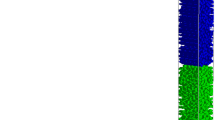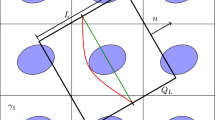Abstract
In this article we introduce a Lippmann–Schwinger formulation for the unit cell problem of periodic homogenization of elasticity at finite strains incorporating arbitrary mixed boundary conditions. Such problems occur frequently, for instance when validating computational results with tensile tests, where the deformation gradient in loading direction is fixed, as is the stress in the corresponding orthogonal plane. Previous Lippmann–Schwinger formulations involving mixed boundary can only describe tensile tests where the vector of applied force is proportional to a coordinate direction. Utilizing suitable orthogonal projectors we develop a Lippmann–Schwinger framework for arbitrary mixed boundary conditions. The resulting fixed point and Newton–Krylov algorithms preserve the positive characteristics of existing FFT-algorithms. We demonstrate the power of the proposed methods with a series of numerical examples, including continuous fiber reinforced laminates and a complex nonwoven structure of a long fiber reinforced thermoplastic, resulting in a speed-up of some computations by a factor of 1000.





















Similar content being viewed by others
Notes
References
Advani S, Tucker C III (1987) The use of tensors to describe and predict fiber orientation in short fiber composites. J Rheol 31(8):751–784. doi:10.1122/1.549945
Altendorf H, Jeulin D, Willot F (2014) Influence of the fiber geometry on the macroscopic elastic and thermal properties. Int J Solids Struct 51(23–24):3807–3822. doi:10.1016/j.ijsolstr.2014.05.013
Anderson Y, Mikelsons M, Tamuzh V, Tarashch I (1991) Fatigue failure of laminated carbon-fiber-reinforced plastic. Mech Compos Mater 27(1):58–62. doi:10.1007/BF00630720
Andrä H, Combaret N, Dvorkin J, Glatt E, Han J, Kabel M, Keehm Y, Krzikalla F, Lee M, Madonna C, Marsh M, Mukerji T, Saenger E, Sain R, Saxena N, Ricker S, Wiegmann A, Zhan X (2013) Digital rock physics benchmarks—Part II: computing effective properties. Comput Geosci 50:33–43. doi:10.1016/j.cageo.2012.09.008
Andrä H, Gurka M, Kabel M, Nissle S, Redenbach C, Schladitz K, Wirjadi O (2014) Geometric and mechanical modeling of fiber-reinforced composites. In: Bernard D, Buffière JY, Pollock T, Poulsen HF, Rollett A, Uchic M (eds.) Proceedings of the 2nd international congress on 3D materials science (3DMS), Wiley, pp 35–40. http://eu.wiley.com/WileyCDA/WileyTitle/productCd-111894545X.html
ASTM International (2013) Standard Test Method for In-Plane Shear Response of Polymer Matrix Composite Materials by Tensile Test of a +/- 45 \(^{\circ }\) Laminate. ASTM International, West Conshohocken. www.astm.org/Standards/D3518.htm
Ball J (1976) Convexity conditions and existence theorems in nonlinear elasticity. Arch Ration Mech Anal 63(4):337–403. doi:10.1007/BF00279992
Barequet G, Har-Peled S (2001) Efficiently approximating the minimum-volume bounding box of a point set in three dimensions. J Algorithms 38:91–109. doi:10.1006/jagm.2000.1127
Bonet J, Wood R (1997) Nonlinear continuum mechanics for finite element analysis. Cambridge University Press, Cambridge
Bonnet G (2007) Effective properties of elastic periodic composite media with fibers. J Mech Phys Solids 55(5):881–899
Brun M, Lopez-Pamies O, Castañeda PP (2007) Homogenization estimates for fiber-reinforced elastomers with periodic microstructures. Int J Solids Struct 44(18–19):5953–5979. doi:10.1016/j.ijsolstr.2007.02.003
Castañeda PP (1996) Exact second-order estimates for the effective mechanical properties of nonlinear composite materials. J Mech Phys Solids 44(6):827–862. doi:10.1016/0022-5096(96)00015-4
Chen L, Chen J, Lebensohn R, Ji Y, Heo T, Bhattacharyya S, Chang K, Mathaudhu S, Liu Z, Chen LQ (2015) An integrated fast fourier transform-based phase-field and crystal plasticity approach to model recrystallization of three dimensional polycrystals. Comput Methods Appl Mech Eng 285:829–848. doi:10.1016/j.cma.2014.12.007
Eisenlohr P, Diehl M, Lebensohn R, Roters F (2013) A spectral method solution to crystal elasto-viscoplasticity at finite strains. Int J Plast 46:37–53. doi:10.1016/j.ijplas.2012.09.012
Flaig C, Arbenz P (2011) A scalable memory efficient multigrid solver for micro-finite element analyses based on ct images. Parallel Comput 37(12):846–854 doi:10.1016/j.parco.2011.08.001. http://www.sciencedirect.com/science/article/pii/S0167819111001037. 6th International workshop on parallel matrix algorithms and applications (PMAA’10)
Fliegener S Micromechanical finite element modeling of long fiber reinforced thermoplastics. Ph.D. thesis, Karlsruhe Institute of Technology (KIT) (to appear)
Fliegener S, Luke M, Gumbsch P (2014) 3D microstructure modeling of long fiber reinforced thermoplastics. Compos Sci Technol 104:136–145. doi:10.1016/j.compscitech.2014.09.009
Gélébart L, Mondon-Cancel R (2013) Non-linear extension of FFT-based methods accelerated by conjugate gradients to evaluate the mechanical behavior of composite materials. Comput Mater Sci 77:430–439. doi:10.1016/j.commatsci.2013.04.046
Geymonat G, Müller S, Triantafyllidis N (1993) Homogenization of nonlinearly elastic materials, microscopic bifurcation and macroscopic loss of rank-one convexity. Arch Ration Mech Anal 122(3):231–290. doi:10.1007/BF00380256
Henning F, Ernst H, Brüssel R, Geiger O, Krause W (2005) LFTs for automotive applications. Reinf Plast 49:24–33. doi:10.1016/S0034-3617(05)00546-1
Herrmann K, Müller W, Neumann S (1999) Linear and elastic-plastic fracture mechanics revisited by use of Fourier transforms—theory and application. Comput Mater Sci 16:186–196. doi:10.1016/S0927-0256(99)00061-0
HEXCEL: 3501-6 Epoxy matrix—high strength, damage-resistant, structural epoxy matrix. http://www.hexcel.com/Resources/DataSheets/Prepreg-Data-Sheets/3501-6_eu.pdf
Hill R (1972) On constitutive macro-variables for heterogeneous solids at finite strain. Proc R Soc Lond A: Math Phys Eng Sci 326(1565):131–147. doi:10.1098/rspa.1972.0001
Hoffmann S (2012) Computational homogenization of short fiber reinforced thermoplastic materials. Ph.D. thesis, University Kaiserslautern, LTM
Kabel M, Böhlke T, Schneider M (2014) Efficient fixed point and Newton-Krylov solvers for FFT-based homogenization of elasticity at large deformations. Comput Mech 54(6):1497–1514. doi:10.1007/s00466-014-1071-8
Kanit T, Forest S, Galliet I, Mounoury V, Jeulin D (2003) Determination of the size of the representative volume element for random composites: statistical and numerical approach. Int J Solids Struct 40:3647–3679. doi:10.1016/S0020-7683(03)00143-4
Kanjarla A, Lebensohn R, Balogh L, Tomé C (2012) Study of internal lattice strain distributions in stainless steel using a full-field elasto-viscoplastic formulation based on fast fourier transforms. Acta Mater 60(6–7):3094–3106. doi:10.1016/j.actamat.2012.02.014
Kaßbohm S, Müller W, Feßler R (2005) Fourier series for computing the response of periodic structures with arbitrary stiffness distribution. Computat Mater Sci 32(3–4):387–391. doi:10.1016/j.commatsci.2004.09.028. http://www.sciencedirect.com/science/article/pii/S0927025604002186. IWCMM
Knowles J (1977) The finite anti-plane shear field near the tip of a crack for a class of incompressible elastic solids. Int J Fract 13(5):611–639. doi:10.1007/BF00017296
Kobayashi S (1957) Theory of connections. Ann Mat Pura Appl 43(1):119–194. doi:10.1007/BF02411907
Lahellec N, Michel J, Moulinec H, Suquet P (2003) Analysis of inhomogeneous materials at large strains using fast fourier transforms. In: Miehe C (ed) IUTAM symposium on computational mechanics of solid materials at large strains, solid mechanics and its applications. Springer, Netherlands, pp 247–258. doi:10.1007/978-94-017-0297-3_22
Lebensohn R, Idiart M, Castañeda PP (2012) Modeling microstructural effects in dilatational plasticity of polycrystalline materials. Proced IUTAM 3:314–330. doi:10.1016/j.piutam.2012.03.020. http://www.sciencedirect.com/science/article/pii/S2210983812000211. IUTAM symposium on linking scales in computations: from microstructure to macro-scale properties
Lebensohn R, Idiart M, Castañeda PP, Vincent PG (2011) Dilatational viscoplasticity of polycrystalline solids with intergranular cavities. Philos Mag 91(22):3038–3067. doi:10.1080/14786435.2011.561811
Lebensohn R, Kanjarla A, Eisenlohr P (2012) An elasto-viscoplastic formulation based on fast fourier transforms for the prediction of micromechanical fields in polycrystalline materials. Int J Plast 32–33:59–69. doi:10.1016/j.ijplas.2011.12.005
Lebensohn R, Rollett A, Suquet P (2011) Fast fourier transform-based modeling for the determination of micromechanical fields in polycrystals. JOM 63(3):13–18. doi:10.1007/s11837-011-0037-y
Lee SB, Lebensohn R, Rollett A (2011) Modeling the viscoplastic micromechanical response of two-phase materials using fast fourier transforms. Int J Plast 27(5):707–727. doi:10.1016/j.ijplas.2010.09.002
Lefebvre G, Sinclair C, Lebensohn R, Mithieux JD (2012) Accounting for local interactions in the prediction of roping of ferritic stainless steel sheets. Model Simul Mater Sci Eng 20(2):024008. http://stacks.iop.org/0965-0393/20/i=2/a=024008
Li J, Meng S, Tian X, Song F, Jiang C (2012) A non-local fracture model for composite laminates and numerical simulations by using the FFT method. Compos Part B: Eng 43(3):961–971. doi:10.1016/j.compositesb.2011.08.055
Li J, Tian XX, Abdelmoula R (2012) A damage model for crack prediction in brittle and quasi-brittle materials solved by the FFT method. Int J Fract 173(2):135–146. doi:10.1007/s10704-011-9671-1
Liu B, Raabe D, Roters F, Eisenlohr P, Lebensohn R (2010) Comparison of finite element and fast fourier transform crystal plasticity solvers for texture prediction. Model Simul Mater Sci Eng 18(8):085005. http://stacks.iop.org/0965-0393/18/i=8/a=085005
Monchiet V, Bonnet G (2013) Numerical homogenization of nonlinear composites with a polarization-based FFT iterative scheme. Comput Mater Sci 79:276–283. doi:10.1016/j.commatsci.2013.04.035
Moore E (1920) On the reciprocal of the general algebraic matrix. Bull Am Math Soc 26:394–395
Moulinec H, Suquet P (1994) A fast numerical method for computing the linear and nonlinear mechanical properties of composites. Comptes rendus de l’Académie des sciences. Série II, Mécanique, physique, chimie, astronomie 318(11):1417–1423
Moulinec H, Suquet P (1998) A numerical method for computing the overall response of nonlinear composites with complex microstructure. Comput Methods Appl Mech Eng 157(1–2):69–94
Müller S (1987) Homogenization of nonconvex integral functionals and cellular elastic materials. Arch Ration Mech Anal 99(3):189–212. doi:10.1007/BF00284506
Müller V, Böhlke T, Kabel M, Andrä H (2015) Homogenization of linear elastic properties of discontinuous reinforced composites—a comparison of mean field and voxel-based methods. Int J Solids Struct. doi:10.1016/j.ijsolstr.2015.02.030. http://www.sciencedirect.com/science/article/pii/S0020768315000761
Ortega J (1968) The Newton-Kantorovich theorem. Am Math Mon 75(6):658–660. doi:10.2307/2313800
Ortega J, Rheinboldt W (1970) Iterative solution of nonlinear equations in several variables. Academic Press, New York
Penrose R (1995) A generalized inverse for matrices. Math Proc Camb Philos Soc 51:406–413. doi:10.1017/S0305004100030401
Peterson C, Ehnert G, Liebold R, Kühfusz R (2001) Compression molding. In: Miracle D, Donaldson S (eds) Composites, ASM handbook, vol 21. Springer, Netherlands, pp 516–535
Prakash A, Lebensohn R (2009) Simulation of micromechanical behavior of polycrystals: finite elements versus fast fourier transforms. Model Simul Mater Sci Eng 17(6):064010. http://stacks.iop.org/0965-0393/17/i=6/a=064010
R&G Faserverbundwerkstoffe GmbH (2009) Faserverbundwerkstoffe Handbuch—composite materials handbook, R&G Faserverbundwerkstoffe GmbH, Waldenbuch
Rollett A, Lebensohn R, Groeber M, Choi Y, Li J, Rohrer G (2010) Stress hot spots in viscoplastic deformation of polycrystals. Model Simul Mater Sci Eng 18(7):074005. http://stacks.iop.org/0965-0393/18/i=7/a=074005
Schneider M, Ospald F, Kabel M (2015) Computational homogenization of elasticity on a staggered grid. Int J Numer Methods Eng. doi:10.1002/nme.5008
Shanthraj P, Eisenlohr P, Diehl M, Roters F (2015) Numerically robust spectral methods for crystal plasticity simulations of heterogeneous materials. Int J Plast 66:31–45. doi:10.1016/j.ijplas.2014.02.006. http://www.sciencedirect.com/science/article/pii/S0749641914000709. Plasticity of textured polycrystals in honor of Prof. Paul Van Houtte
Sliseris J, Andrä H, Kabel M, Dix B, Plinke B, Wirjadi O, Frolovs G (2014) Numerical prediction of the stiffness and strength of medium density fiberboards. Mech Mater 79:73–84. doi:10.1016/j.mechmat.2014.08.005
Spahn J, Andrä H, Kabel M, Müller R (2014) A multiscale approach for modeling progressive damage of composite materials using fast fourier transforms. Comput Methods Appl Mech Eng 268:871–883. doi:10.1016/j.cma.2013.10.017
Suchocki C (2011) A Finite element implementation of knowles stored-energy function: theory, coding and applications. Arch Mech Eng 58(3):319–346. doi:10.2478/v10180-011-0021-7
Todd R, Allen D, Alting L (1994) Manufacturing processes reference guide. Industrial Press. https://books.google.de/books?id=6x1smAf_PAcC
Vinogradov V, Milton G (2008) An accelerated FFT algorithm for thermoelastic and non-linear composites. Int J Numer Methods Eng 76(11):1678–1695. doi:10.1002/nme.2375
Willot F, Gillibert L, Jeulin D (2013) Microstructure-induced hotspots in the thermal and elastic responses of granular media. Int J Solids Struct 50(10):1699–1709. doi:10.1016/j.ijsolstr.2013.01.040
Zeman J, Vondřejc J, Novák J, Marek I (2010) Accelerating a FFT-based solver for numerical homogenization of periodic media by conjugate gradients. J Comput Phys 229(21):8065–8071. doi:10.1016/j.jcp.2010.07.010
Acknowledgments
MS gratefully acknowledges financial support by the German Research Foundation (DFG), Federal Cluster of Excellence EXC 1075 “MERGE Technologies for Multifunctional Lightweight Structures”..
Author information
Authors and Affiliations
Corresponding author
The Lippmann–Schwinger equation with mixed boundary conditions and gradient descent
The Lippmann–Schwinger equation with mixed boundary conditions and gradient descent
Similarly to [25], we exhibit the fixed point scheme for the generalized Lippmann–Schwinger equation (12) as a gradient descent method, explaining its basic mechanisms and particularly proofing convergence of Algorithm 1.
Using the \(\mathbb {C}^0\)—weighted \(L^2\)—inner product
we want to compute the gradient of
i.e. setting
we need to solve
for all G of the form \(G=\langle G\rangle _Y+\nabla v\) with \(\mathbb {P}:\langle G\rangle _Y=0\). Inserting the definition, (26) reads
which decomposes into the two equations
The first equation becomes
i.e. with \(\mathbb {P}:\bar{P}=0\) and \(\mathbb {M}=(\mathbb {Q}:\mathbb {C}^0:\mathbb {Q})^\dagger \) we have
The second equation implies
see [25]. Consequently, the gradient reads
A forward Euler discretization (with time step \(\Delta t\)) of the negative gradient flow for f becomes
Inserting
we get
Using
we arrive at the expression
which, for time step \(\Delta t=1\), is nothing but the Lippmann–Schwinger equation (12).
Rights and permissions
About this article
Cite this article
Kabel, M., Fliegener, S. & Schneider, M. Mixed boundary conditions for FFT-based homogenization at finite strains. Comput Mech 57, 193–210 (2016). https://doi.org/10.1007/s00466-015-1227-1
Received:
Accepted:
Published:
Issue Date:
DOI: https://doi.org/10.1007/s00466-015-1227-1




